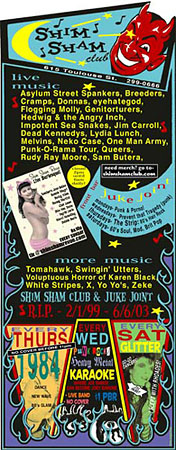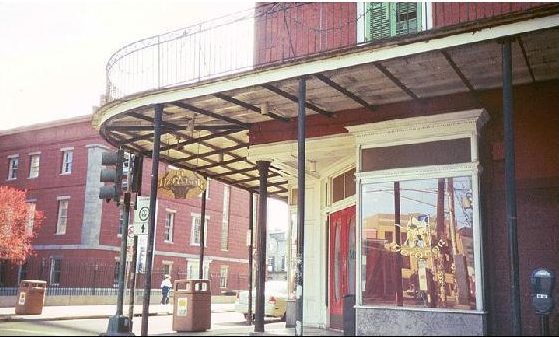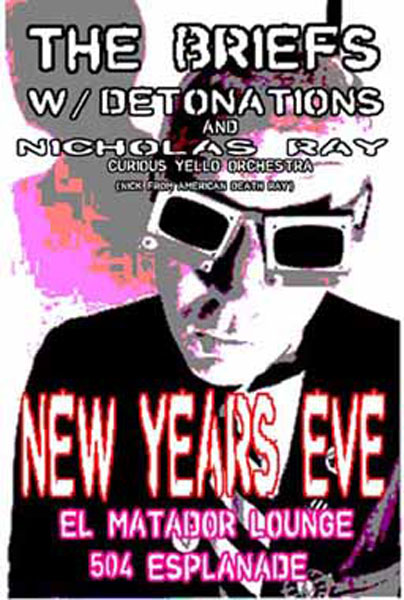The French Quarter of New Orleans is often known for its vibrant culture and unparalleled music scene. From the collaboration of rock and roll staple, El Matador and New Orleans’s historic Shim Sham Club came One Eyed Jack’s, a new age punk club reminiscent of the avant garde and antiquated burlesque atmosphere introduced by its predecessors. Located in the 600 block of Toulouse Street in New Orleans, it belongs to a stretch of establishments that create their own world, catering towards a metal and rock and roll demographic. One Eyed Jack’s provides a venue for those seeking refuge in the French Quarter from Bourbon Street and the tourists not looking for the stereotypical New Orleans experience.

A wild and colorful ad for the Shim Sham Club. Photo by Sean Yseult.
Before One Eyed Jack’s opened, the location was the Shim Sham Club, a hollywood owned rock and roll and burlesque club most well known for its theme nights, theater, and burlesque show, the Shim Sham Revue. It opened in 1999, and represented not only a new genre of collaborative entertainment, but the era of the “Neo-Burlesque”, the revival of traditional burlesque in more modern day venues (Martiniere, Madeleine. “Modern Burlesque and the Creation of Identity.” Creative Taboo. N.p., 24 2010. Web. 6 Dec 2012). Morgan Higby Night, the founder of the Shim Sham Club, was known for his burlesque troupe, the Shim Shamettes. It was one of the first nationwide troupes to exist and became a staple in the burlesque world. This, along with the Shim Sham Revue and its one of a kind shows, caused the club to become nationally renowned as one of the best avant garde/rock and roll venues around. Famous acts such as X, the White Stripes, Counting Crows, and Rudy Ray Moore were all featured at the Shim Sham Club in their early days of fame. The Shim Sham Club was extremely successful for a venue of such a unique nature at the time. “When you start thinking about it, there’s not a lot of places to do it,” says Ronnie Magri, the bandleader of the Shim Sham Revue. “It’s 50/50 as far as locals and tourists, and if you do it Uptown, you’re not going to get any tourists, and if you do it on Bourbon Street, you won’t draw many locals.“ With a steady mixture of both locals and tourists, it became a staple in French Quarter nightlife. Its apparent success was the reason that the sudden closing was a surprise to Magri and several of the regular acts. The club closed in its traditional fashion on June 6th, 2001 at 6 AM with its popular heavy metal night (Jordan, Scott. “The Shuttering of the Shim Sham Club.” Gambit. Best of New Orleans. N.p., 27 2003. Web. 16 Nov 2012).
 The exterior of Rock n’ Roll club Matador. Photo by Virtual Tourist.
The exterior of Rock n’ Roll club Matador. Photo by Virtual Tourist.
Los Angeles native and well known director Taylor Hackford owned a few properties around the city. In 1999, one of these spaces, a small gay club called The Mint at 1331 Decatur Street, was in the process of losing its license, and Taylor Hackford enlisted the help of his son Rio Hackford to save the space. From this endeavor came the rock and roll club, El Matador.
“El Matador was definitely a special moment in time. A rock ‘n’ roll bar didn’t really exist at the time. Its success has a lot to do with the varied musicians I have met along the way and who would come to see me there…And once we started having live music, it became the heartbeat of the rock ‘n’ roll scene in New Orleans…All those bands that have subsequently become the premiere bands in New Orleans all cut their teeth there. Plus, being an outsider coming in and being able to survive in a “locals” town was due to the fact that people of the underground music scene embraced me” (“Underground Sounds.” New Orleans Living Magazine, n.d. Web. 16 Nov 2012).

An advertisement for The Briefs at El Matador Lounge. Photo by Gigposter.
El Matador was hugely popular in the area, but would only house up to a few hundred people.
At the time of the Shim Sham Club’s closing, Rio Hackford was approached by Morgan Higby Night to take over the space. Hackford, along with Ryan Hesseling and Cory Allen then opened One Eyed Jack’s in April 2002. The loyal crowds from El Matador began to patronize the establishment, and now the bands could play for crowds twice the size, taking advantage of the Toulouse Theater space. The name “One Eyed Jack’s” came from the Marlon Brando, cult-western movie of the same name. Derived from this movie was Rio Hackford’s namesake as well, as the lead character of “Rio the Kid” played by Marlon Brando.Hackford essentially moved the old El Matador to this new location and integrated it into the classical burlesque vision left behind by the Shim Sham Club.
Rio Hackford’s “affinity for mexican culture” allowed for a seamless transition from El Matador’s decorum to that of One Eyed Jack’s. The velvet and damask wallpaper remained, highlighted by a red, black, and gold scheme that “echoes mexican saloons and bordellos.” The original, large circular bar, several pieces of art, and a large chandelier are also vestiges of El Matador still present in One Eyed Jack’s. The architecture of the Toulouse Theater space is a prime location for large concerts, comfortably seating up to four hundred people and the high ceilings and original wooden floors provide a space with excellent sound quality for such large shows. Lastly, an El Matador tribute room, located on the second floor of One Eyed Jack’s, is used for special events.

One Eyed Jack’s concert space. Photo by One Eyed Jack.
The musical acts featured at One Eyed Jack’s are oriented towards the punk rock genre, but as owner Rio Hackford stated, “I appreciate jazz as the heritage and history of New Orleans, but One Eyed Jack’s first and foremost is a rock ‘n’ roll club. But we leave the door open for everyone. With the Burlesque shows and other jazz stuff that we offer, showing movies and the 80’s dance night, there is a variety; it does have something for everybody” (“Underground Sounds.” . New Orleans Living Magazine, n.d. Web. 16 Nov 2012). One Eyed Jack’s works hand in hand with locals, including Tulane University radio station WTUL to coordinate biweekly shows promoting both local and underground music. The shows are oriented towards the younger, college-age demographic (WTUL: New Orleans 91.5 FM. N.p., n. d. Web. Web. 13 Dec. 2012).
 NOLAbeings Multimedia artist Claire Bangser created NOLAbeings as a portrait-based story project that marries...
NOLAbeings Multimedia artist Claire Bangser created NOLAbeings as a portrait-based story project that marries...  Voodoo in New Orleans: Reviving history: New Orleans fortune telling This article takes a deep dive into the history of Voodoo in New Orleans, its hybridization with Catholicism, and its present-day place in the city's culture. The author visits fortune-tellers in the French Quarter, using their guidance as a tool for introspection rather than a deterministic predictor of the future. Through her experiences in New Orleans, the author feels a mystical connection to both the past and the future.
Voodoo in New Orleans: Reviving history: New Orleans fortune telling This article takes a deep dive into the history of Voodoo in New Orleans, its hybridization with Catholicism, and its present-day place in the city's culture. The author visits fortune-tellers in the French Quarter, using their guidance as a tool for introspection rather than a deterministic predictor of the future. Through her experiences in New Orleans, the author feels a mystical connection to both the past and the future. 